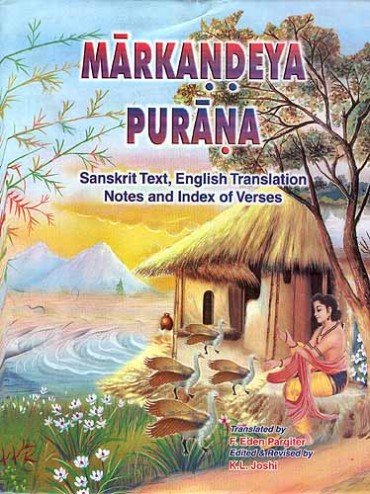The Markandeya Purana
by Frederick Eden Pargiter | 1904 | 247,181 words | ISBN-10: 8171102237
This page relates “the majesty of the sun” which forms the 102nd chapter of the English translation of the Markandeya-purana: an ancient Sanskrit text dealing with Indian history, philosophy and traditions. It consists of 137 parts narrated by sage (rishi) Markandeya: a well-known character in the ancient Puranas. Chapter 102 is included the section known as “conversation between Markandeya and Kraustuki”.
Canto CII - The Majesty of the Sun
Mārkaṇḍeya says that from Brahmā’s mouths issued the four Vedas and explains their peculiar qualities and transcendent merits—The gods and the Vedas are but manifestations of the Sun.
Mārkaṇḍeya spoke:
Now when that egg split open, out of the anterior mouth of Brahmā whose origin is inscrutable, O muni, came forth first the Ṛc hymns, at once resplendent as the flowers of the China rose,[1] glorious in form, but disconnected,[2] and divided into separate portions, and therefore bearing the form of passion.[3] Out of his right mouth issued the Yajus hymns, unimpeded, coloured like the colour of gold, and disconnected. Out of the posterior mouth of the lord Brahmā, who is the highest of all, were revealed the Sāman hymns, and the Chandas hymns. And the entire Atharvan[4] then, resplendent as a mass of black pigment or a cluster of bees,—that which has a nature as terrible as possible,[5] which contains the magical rites and the rites for removing calamities,—became manifest out of the Creator’s left mouth; it is composed chiefly of pleasure, goodness and darkness,[6] and has the essential properties of gentleness and harshness. The Ṛc hymns have the quality of passion; and goodness is the quality[7] of the Yajus hymns, O muni; the Sāman hymns have the quality of darkness; darkness and goodness exist in the Atharvan hymns. These emanations, blazing indeed with unrivalled glory, obtained each a separate station almost at firsts.[8]
That then was the original glory which is declared[9] by uttering the word “Om.” The glory which comes from the essential nature thereof—that, having encompassed it completely, remains fixed. As is the glory which consists of the Yajus, such is that of the Sāmans, O great muni; they have grown into one in resorting to a supreme glory. Rites for the removal of calamities, and rites for promoting growth and magical rites also—these three things gained union[10] with the three Vedas, the Ṛc and the two others, O brāhman.
This universe became most stainless then through the sudden destruction of darkness, and was to be developed horizontally, upwards and downwards, O brahman ṛṣi. That excellent glory of the Chandas became then an orb, and grew into oneness with the supreme glory, O brālimau. Since it obtained the name of Āditya at the very beginning, it became also the essentially unchanging cause of this universe, O illustrious Sir.
The triple Veda, which is named the Ṛc, Yajus and Sāman, gives warmth in the morning and at midday and in the afternoon also. The Ṛc hymns give warmth in the forenoon, and the Yajus hymns truly at midday, and the Sāman hymns give warmth truly in the afternoon, O best of munis. Rites for the removal of calamities are deposited[11] in the Ṛc hymns in the forenoon, rites for promoting internal growth in the Yajus hymns at midday, and magical rites lastly in the Sāman at evening. Magical rites moreover should be performed at midday and in the afternoon equally, but the particular ceremonies for the Pitṛs should be performed with the Sāman in the afternoon.
In the creation of the world is manifested Brahma, who is composed of the Ṛc hymns; in its permanence[12] Viṣṇu who is composed of the Yajus hymns; and Śiva, who is composed of the Sāman, at the dissolution; therefore its sound is impure.[13] Thus the adorable Sun, whose self is the Veda, who abides in the Veda and whose self is Vedic knowledge, is called the Supreme Soul.[14] And he, the eternal, who is the cause of creation,[15] permanence and dissolution, on taking recourse to passion, goodness and the other qualities, acquires the names of Brahmā, Viṣṇu and the other gods.
Now ever to be praised by the gods is he whose body is the Veda,
Yet who has no body, who was in the beginning, who is embodied in ail mortals;
Who is the Light that is the refuge of the universe, who has righteousness that passes knowledge,
Who is to be attained unto in the Vedānta, supreme beyond things that are sublime!
Footnotes and references:
[1]:
Java; Hibiscus rosa Sinensis. The flowers are very large and of a brilliant crimson-scarlet colour, very conspicuous.
[2]:
Not in the order in which they are now arranged. For tejo-rūpānta-saṃhatāḥ the Bombay edition reads tejo-rūpā hy a-saṃhatāḥ, which I have adopted.
[3]:
Rajo-rūpa-vahās.
[4]:
Atharvāṇam, neut. nomin. The meaning given in the dictionary is " the work, i.e., ritual of the Atharva-Veda,” but here it must mean the Atharva-Veda itself. This Veda receives marked praise here.
[5]:
Yāvad-ghora-svarūpaṃ tad.
[6]:
Sukha-sattva-tamaḥ-prāyam ; Hukha is peculiar in this connexion.
[7]:
For guṇā read guṇo ? It is remarkable that a higher quality is given to the Yajur-Veda here than to the Ṛg-Veda.
[8]:
Pūrvam iva.
[9]:
Abhi-śabdyate ; abhi-śabd as a verb is not in the dictionary.
[10]:
Layam agamat. The reference seems to be to the Atharva-Veda; see verse 5 where these rites are said to be part of that Veda. This passage then refers to the changes by which that work gained rank as a Veda. But these words may also mean “became blended with the three Vedas;” see verse 17 below.
[11]:
Vinyastaṃ.
[12]:
For sthito read sthitau as in the Bombay edition.
[13]:
Manu says the sound of the Sāma-Veda is in a measure impure because it is sacred to the Pitṛs (IV. 124).
[14]:
Paraḥ, puruṣaḥ.
[15]:
For svarga- read sarga- as in the Bombay edition.
